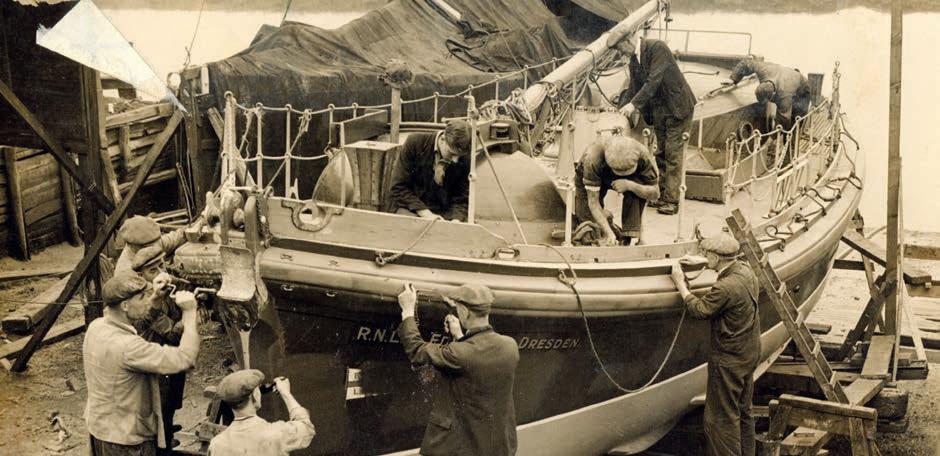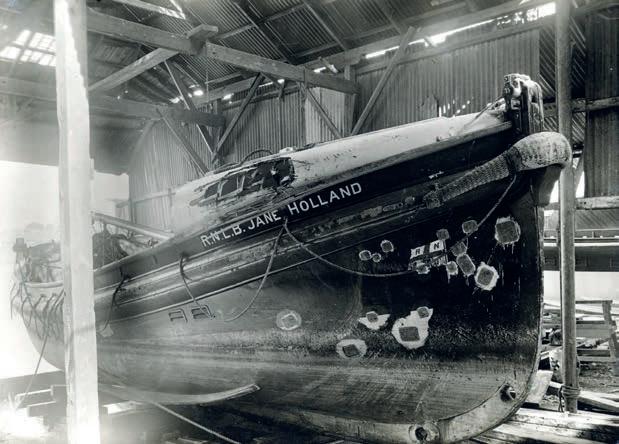
5 minute read
TRIUMPH AND TRAGEDY
from All At Sea June 21
by All At Sea
TRUMPH AND TRAGEDY
We revisit the triumph and tragedy of RNLI crews during the war years.
Advertisement
Men at work on the RNLB, Sir Edward Z Dresden, the Clacton lifeboat that took part in the evacuation of men from Dunkirk beaches. Image: Fox Photos
From being gunned down by German aircraft to getting blown up by a floating mine, being washed overboard during heroic rescue missions to getting caught in an air raid, 37 lifeboat crew lost their lives during the period of the two World Wars.
Despite being dedicated to saving lives, seven RNLI lifeboats were also tragically lost in various ways during World War II – from air-raids on lifeboat stations to being captured.
Hayley Whiting, RNLI heritage archive and research manager, explained: “Our lifeboat crews had some challenging times throughout the war years, with lifeboats and lifeboat stations being damaged and sadly, the loss of life of some of our crew. For heroic lifeboat services during the war years a total of 283 gallantry medals were awarded for outstanding bravery.”
Here we look back at some of the stories behind the headlines.
In 1940, the RNLI’s St Peter Port lifeboat from Guernsey was heading to St Helier lifeboat station on Jersey and then on to England. During the journey, it was machine-gunned by three German aircraft and, sadly, a member of the crew,
Harold Hobbs, who was the coxswain’s son, was killed.
A year later in 1941, just a few days before Christmas, Coxswain Jack
Slade and shore signalman Thomas
Escott went out in the coxswain’s boat to investigate a floating object. On getting closer it was revealed to be a floating mine, which tragically exploded destroying the boat and killing both men. Also in 1941, Thomas Pratt, an RNLI mechanic, lost his life while covering at
Falmouth lifeboat station when an air raid struck the town.
Thousands saved Although lifeboat crew were lost, some directly due to the war, and some undertaking routine rescues in horrendous conditions in rowing and sailing lifeboats, all was not in vain as lifeboats worked tirelessly to save those in peril.
During the first and second World Wars lifeboats launched 5,478 times and saved a staggering 11,698 lives.
With thousands of younger men being called to serve their country on the front line, the average age of RNLI lifeboat crews increased with lifeboats crewed by 50, 60 and 70-year-olds.

The Jane Holland Eastbourne lifeboat showing the damage she sustained during the Dunkirk evacuation in May/June 1940. Image: RNLI

Cox Edward Drake Parker (centre), with his son James on his right and son Edward. All three took part in the evacuation of Dunkirk. Image: A C Robinson Lusitania survivors On 7 May 1915, the British ocean liner RMS Lusitania was torpedoed and sunk by a German submarine, causing the deaths of 1,198 passengers and crew. She was 11 miles off the southern coast of Ireland and had been on her way to Liverpool from New York.
All available tugs and trawlers were sent to the scene including Queenstown’s motorless RNLI lifeboat James Stevens No. 20, which was towed to the scene by one of the tugs. They were able to help those who had been fortunate enough to make it into one of the ship’s lifeboats and to pull to safety the few still alive in the water. There were 761 survivors. A further 14 volunteers from Courtmacsherry launched their lifeboat, and with no wind to sail the lifeboat they rowed the entire 12 miles, taking three-and-a-half hours. They arrived to a devastating scene with no one left alive to save. So the crew set about recovering the bodies to bring home to loved ones.
In total, more than 338,000 men were rescued between 26 May and 4 June, of which over one-third (98,000) were evacuated by Dunkirk’s ‘Little Ships’. The original target for Operation Dynamo had been to evacuate 45,000.
Further reading A full account of the Dunkirk rescue can be read at shorturl.at/bfAC1.
About the RNLI Funded by voluntary donations, the RNLI is the charity that saves lives at sea around the UK and Ireland. It relies on thousands of dedicated volunteers who are on-call 24/7, ready to risk their lives to save others in danger on the sea. The RNLI operates over 238 lifeboat stations in the UK and Ireland and lifeguard units on beaches around the UK and Channel Islands. rnli.org
Admiralty’s request, to take part in the evacuation of British troops from the French port of Dunkirk. A total of 19 RNLI lifeboats were part of this historic and daring force, known as the Little Ships.
With many of the lifeboats being taken charge of by military personnel, two lifeboats from Ramsgate and Margate took part in their toughest mission yet with their own RNLI crews on board. They packed some unfamiliar equipment on board: steel helmets, gas masks, grass towing warp and extra supplies of fuel and fresh drinking water.
Their orders? To bring the soldiers off the beaches and into the safety of the rescue ships waiting offshore. Battling strong tides and dodging enemy fire, boats and wreckage, Ramsgate’s lifeboat crew helped to collect soldiers from the beach.
They kept going for 30 hours, even then, the work of the lifeboat did not stop. After a long trek back across the channel to Ramsgate, the crew were in action again, bringing injured troops ashore from other vessels.

Coxswain Howard P Knight displaying medals and his official hat. He took the Ramsgate lifeboat to Dunkirk in 1940. Image: RNLI Here are two RNLI crew members, both wearing oilskins, kapok lifejackets - Lizard Station. Image: RNLI












